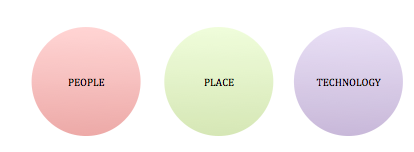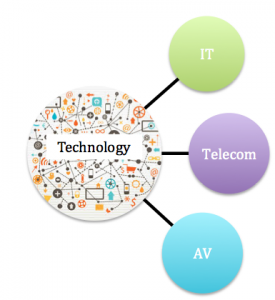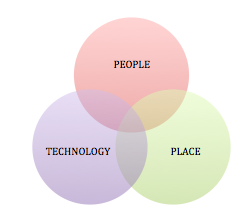
People, Place and Technology are Coming Together like Never Before
The Workplace of the Future

Technological advances are catalysts for change in any business, and those changes are happening at a faster pace than ever before. Technology is transforming who we are able to work with and how we work with them, so it can no longer be considered an afterthought when designing the workplace.
Historically, the workplace is where people come together to work. Relating the importance of the “Place” to design so that people could work more effectively was a natural progression of thoughtful study and experimentation. Design, furniture and furnishing organizations have steadily advanced over the years to better understand the relationship between People & Place and to bring those findings to bear in their products and services.

Technology, until the late 70s or early 80s, really had no place as part of the workplace other than the telephone. There really was no option for remote workers being part of the day-to-day team. If you did need to meet with colleagues, you had to travel. And airline travel for business boomed in the 70s, 80s and 90s.
And then the conference call became a way to allow remote participants to connect by phone call to a meeting – telecom technology. This small advance was a big thing! People didn’t have to travel just to participate, but it still wasn’t as good as being there. There were cost savings, productivity gains and new models of working together that were enabled by this advance. People who were conferenced into the meeting were soon asking for better sound quality. This requirement introduced the need for good Audio-Visual (AV) in meeting rooms.
Computer terminals and networks were part of the workplace in the 60s to 80s but it wasn’t until the PC came along in the early 80s that a PC was a commonplace personal technology for the workplace. Even then it was more a personal technology that was connected to the corporate network/Internet and sat on desktops with limited design or thought required to integrate it into the workplace.
Another thing that was important in the workplace was sharing information in a meeting. The early tools used to do this were blackboards, which later became flip charts and whiteboards. Foil projectors and slides were technological advances for content sharing, when it became important to have prepared content to share in a meeting. Then PowerPoint arrived and the AV technology’s importance as part of a meeting room grew so the PowerPoint could be shared with everyone in the room.
Then people wanted to share those PowerPoint slides with the remote participants and WebEx and other tools filled that market need. The introduction of WebEx also required the meeting rooms to be connected to the corporate network – now IT was increasing its role as part of the workplace technology equation. IT and AV were now working together.
In the technology world, Telecom, IT and AV had all grown up independently and were considered separate areas of technology discipline. They were all silos of technology in the workplace. Today there is a need to create the right balance of 4 different conferencing technologies for meeting rooms.

The simplified story of technology evolution into the workplace (above) highlights the requirement for the separate technology disciplines to come together and be managed as one. This trend is accelerating today fueled by an ever-increasing requirement to connect in real-time and the ability to connect everything to the network. Some of the specific technology evolutions that are driving the requirement to connect “People & Place” with “Technology” are:
- Unified Communications & Collaboration (UC&C)
- Smart Buildings – many sub-categories here
- Digital Signage
- Workspace Management

These technology changes are having a huge affect on the workplace. In fact the biggest effect they are having is on the requirement for how much workspace is required. In some cases companies are seeing real estate space reductions of up to 70%. With real estate being one of the largest expense items for any organization, a large reduction can have a huge effect on the bottom line, but reducing real estate without consideration for a number of other factors can be perilous. The key is to ensure that the technologies do not collide in the workplace but that they are integrated into the workplace to allow people to connect to the workspace and the workspace to connect to the building.
To learn more about how technology is driving change in the workplace and how to manage that change, please join me for the webinar, “Integrating Technology as Part of the Office Re-design”, on June 24th.
Go here to Register.
Author: Paul Gragtmans
 Paul has more than 30 years of experience in the IT and AV technology industries and brings a practical and insightful approach to today’s technology environment. He is working with some of the largest Canadian companies in a consultative role, helping them sort through the collaborative technologies available to them. He has developed a Corporate Collaborative EcoSystem model which allows organizations to:
Paul has more than 30 years of experience in the IT and AV technology industries and brings a practical and insightful approach to today’s technology environment. He is working with some of the largest Canadian companies in a consultative role, helping them sort through the collaborative technologies available to them. He has developed a Corporate Collaborative EcoSystem model which allows organizations to:
Understand the dynamics of the collaborative technologies
Determine their current position in the use of the technologies
Draw up a plan which meets their goals for increased collaboration
Assists them with the integration and management of the technologies
Paul has held leadership positions at both large corporate companies, e.g. IBM Canada – General Manager positions, and at several technology start ups. His results-oriented drive, real world insight and innovative leadership have spawned successful strategies, coupled with practical planning and implementation.
His focus at ET Group is to bring ongoing value to the customer.
Tags:


